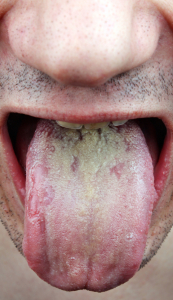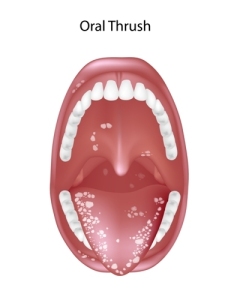Oral candidiasis (thrush or moniliasis) is common in babies.
The mucous membranes are thinner in this age group and milk sugar is around, which will feed the yeast bugs.
The first signs are that the baby is fussy and does not want to feed. When the tongue and the cheek surfaces are inspected from inside, then it is apparent that white plaques are attached to inflamed areas. This is what the physician looks for to make the clinical diagnosis. Another name for this condition is also “oral thrush”, moniliasis or Candidiasis.
There are other condtions where thrush is common, namely in patients with diabetes mellitus with high blood sugar (poorly controlled diabetics).
In older people, particularly when they are in nursing homes, oral thrush is also found more frequently on routine examinations. Partially this may be due to poor oral hygiene, partially because more patients in this age group wear dentures and any foreign body in the mouth like this will provide more surfaces where the Candida albicans, the medical name for yeast bugs, can grow.
Treatment
Nystatin is usually quite effective in these situations when given as oral solution. For more resistant cases the doctor may use fluconazole (brand name: Diflucan), although there can be some side effects such as liver toxicity and this would have to be monitored.
References:
1.The Merck Manual, 7th edition, by M. H. Beer s et al., Whitehouse Station, N.J., 1999. Chapter 158.
2.The Merck Manual, 7th edition, by M. H. Beers et al., Whitehouse Station, N.J., 1999. Chapter 113.
3. The Merck Manual, 7th edition, by M. H. Beers et al., Whitehouse Station, N.J., 1999. Chapter 164.
4.David Heymann, MD, Editor: Control of Communicable Diseases Manual, 18th Edition, 2004, American Public Health Association.








